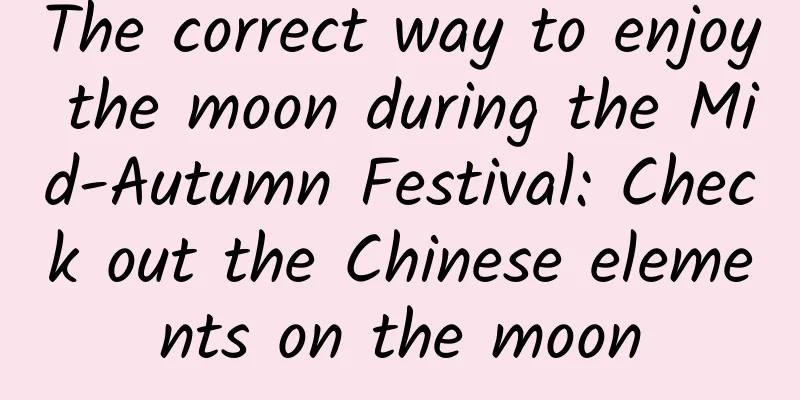The correct way to enjoy the moon during the Mid-Autumn Festival: Check out the Chinese elements on the moon

|
It’s Mid-Autumn Festival again, a time to appreciate the moon. Image source: veer gallery The ancients looked at the moon relying on their imagination, and what they saw was the myth that has been passed down to this day: Chang'e lived in Guanghan Palace holding the Jade Rabbit, and Wu Gang was chopping down an osmanthus tree. Thanks to the development of aerospace technology, when we look at the moon today, we can actually see the mountains, basins, and craters on the moon... Not only that, people today have also turned the ancients' wild imaginations into reality. Our "Chang'e" and "Jade Rabbit" have really been to the moon, and the moon has really become the "Guanghan Palace." From the myth of Chang'e flying to the moon to the current lunar exploration program, our questioning and exploration of the universe has never stopped. This Mid-Autumn Festival, let us take stock of the Chinese elements and footprints left on the moon. Part 1 In the early days, the names of lunar landforms were based on personal preference. To talk about Chinese elements, we must first start with the naming rules of "lunar geographical entities". The so-called lunar geographical entities refer to the landforms such as mountains, basins, and craters on the moon. In the early days, the naming of lunar features was quite random. The first person to name a lunar feature was Galileo, who named the highest mountain on the moon after the Apennine Mountains in his hometown. Since then, astronomers have followed suit and named lunar features with their favorite names. During this period of chaotic naming, some obvious features on the lunar surface were even given at least three different names. Lunar elevation map (Image credit: NASA) During this period, it is worth mentioning that astronomer Grimaldi and his mentor Father Riccioli published a book together, called "New Almagest", which laid the foundation for the official naming rules used today for the naming of lunar features. In this book, they named large areas after weather (such as Mare Tranquila, Mare Imbrium, Oceanus Procellarum, etc.) and named craters after famous scientists. The most spectacular craters on the moon, such as Tycho Crater, Copernicus Crater and Archimedes Crater, were all named at this time. Composite image showing Tycho crater from above (Image source: NASA) The early confusion ended in 1919 when the International Astronomical Union (IAU) was established and a lunar nomenclature working group was set up to standardize the naming of lunar features. In 1935, official naming guidelines were published, and astronomers finally stopped arguing over names. Part 2 The US-Soviet rivalry: another naming contest for the far side of the moon After the astronomers ended their dispute, the United States and the Soviet Union engaged in a fierce struggle for a period of time over the naming of the landforms on the back of the moon. In 1959, the Soviet Union's Luna 3 unmanned lunar probe sent back images covering 70% of the far side of the moon for the first time. As the mystery of the far side of the moon was slowly unveiled, the Soviet Union began to name the landforms on the far side of the moon using Soviet elements such as Soviet scientists, astronauts and place names. For example, "Tsiolkovsky Crater", "Mendeleev Crater" and "Moscow Sea" were all named during this period. Due to the low resolution of the image, some landforms were incorrectly identified and named at the time. For example, the bright rays in the Bruno crater were mistaken for mountains and named the "Soviet Mountains". Of course, they have now been deleted from the map. The United States was not far behind. As American probes continued to send back photos, some craters were named after scientists and astronauts. For example, craters near the lunar poles were often named after famous polar scientists and explorers, such as Shoemaker, Nansen, Shackleton and Amundsen. A notable exception is Apollo Basin, which was named in honor of the Apollo missions rather than after scientists, but several small craters around Apollo Basin are named after deceased astronauts, including the lost astronauts of Apollo 1 and the crews of the Challenger and Columbia space shuttles. Part 3 International standards, common compliance In 1935, the IAU (International Astronomical Union) defined official naming rules, including naming methods for 17 types of lunar terrain, including oceans, seas, plains, etc. Each country can apply to the IAU to name lunar geographical entities according to the official rules. Not only that, the lunar geographical entity to be named must itself meet specific conditions. For example, the diameter of the feature must be greater than 100 meters and it must have special scientific research and application value. Naming it will help with lunar research and lunar surface mapping. Secondly, various naming rules must be followed. Generally speaking, there are the following four naming rules. 1. Use the name of a scientist or explorer (preferably an astronomer) who has made significant contributions and has been dead for at least three years before the naming. This method is mainly used to name craters, ridges, some capes and mountains on the moon. For example, Copernicus Crater, Archimedes Crater, Galileo Crater, Plato Crater, etc. There are many derived place names in this type of naming rules. For example, the names of many crater chains, rilles, cliffs, valleys and satellite craters are derived from the names of nearby craters. For example, Cauchy Ridge and Cauchy Cliffs are named after the nearby Cauchy craters. The names of satellite craters (small impact craters in the crater) are the parent crater name + capital letter suffix. These English letter suffixes usually indicate their position relative to the crater (A-Z is arranged in sequence), for example, M means the direction of point M in the crater. 2. Name it based on existing place names on the earth. This method is mainly used to name some mountains and capes of the Moon Mountains, such as the Alps, Apennines, Caucasus, etc. 3. Name them according to Latin words that describe weather and other abstract concepts. This method is mainly used to name water-related terrains such as the lunar ocean, lunar sea, lunar bay, lunar lake, lunar swamp, plains, etc., such as the Ocean of Storms, Sea of Wisdom, Dream Lake, Rainbow Bay, etc. 4. Self-naming. Each country can name the landing site of their lunar exploration activities independently. For example, the landing site of Chang'e 3 was named Guanghan Palace, the landing site of Chang'e 4 on the back of the moon was named Tianhe Base, and the landing site of Chang'e 5 was named Tianchuan Base. Tianhe Base and Tianchuan Base are the only three bases (Statio) on the moon, along with the "Sea of Tranquility Base" where Apollo 11 completed the first human landing on the moon. The distribution of thorium content on the lunar front and the Chang'e 5 landing area (white frame), A represents the Apollo sampling point, L represents the Luna sampling point, among which A12, 14 and 15 are also located in the Klip terrane of the Ocean of Storms (Image source: Reference [1]) Since the 21st century, new lunar geographical discoveries have dropped significantly, and the number of approved names has also dropped accordingly. Since applicants are required to provide their own scientific discoveries and detailed information on geographical entities, this basically means that only countries with lunar exploration and related scientific research capabilities can do so. At present, any approval of the name of a lunar landform means a great contribution to lunar research. As you can imagine, independent naming basically means a new lunar probe, which is an honor for any country. Part 4 Chinese names on the moon There are 35 Chinese place names on the moon, including 3 landing sites, 22 craters, 2 lunar streams, 5 satellite craters and 3 mountain ranges. Among the 22 lunar craters, 14 were named after scientists, which is in line with the IAU naming rules. The second largest number of names are related to ancient mythology, accounting for 7. After the landing of Chang'e 3, my country was approved to name the landing site with Guanghan Palace, and three small craters nearby were also named Ziwei, Tianshi and Taiwei, which set a precedent for using names from the ancient Chinese astronomical system to name lunar geographical entities. It is worth noting that among the 35 Chinese place names, 15 were named before 2007. At that time, China did not directly participate in the naming of the moon, but the IAU chose them on its own, including Zhang Heng, Zu Chongzhi, Guo Shoujing, etc. There are also some names whose origins cannot be determined, such as the Jingde Crater. Some say it is named after Jingdezhen in Jiangxi, while others say it is named after a common Chinese male name. There is no definitive answer yet. We also cannot confirm the origins of the two Yuexi names pronounced "Wan-Yu" and "Sung-Me". They are probably also common Chinese female names. In 2007, Chang'e-1 opened the curtain of my country's lunar exploration project. Since then, China has joined the naming army. After that, my country has independently applied for and obtained approval for 20 names. With the successful landing of Chang'e-3 to Chang'e-5 on the moon, my country has named more and more lunar geographical entities. Names of lunar features in China (Image source: self-made by the author) At the same time, it should be noted that the Tianjin crater near the Tianhe base does not refer to the Chinese municipality of Tianjin. Tianjin means the crossing of the Milky Way. Vega, Hegu II (commonly known as Altair) and Deneb IV, these three bright stars form the famous "Summer Triangle", which is also the corresponding constellation in the legend of the Cowherd and the Weaver Girl. Coincidentally, the positions of these three craters on the moon surface approximately reproduce the astronomical phenomenon of the "Summer Triangle", which also echoes the name of the relay star Magpie Bridge, and together restores the myth of the Cowherd and the Weaver Girl meeting on the Magpie Bridge. In the future, our exploration of the moon will continue to deepen. What other names full of Chinese elements may appear on the moon? We cannot answer this question at present, but what is certain is that there will be more and more Chinese footprints on the moon. In the past, when we looked up, the sky was full of myths, which were the imaginations and questions of the ancients thousands of years ago. Today, "Chang'e" flies to the moon, "Magpie Bridge" rises into the sky, "Jade Rabbit" runs, "Zhurong" falls into the fire, "Heavenly Palace" is completed, "Beidou" points the way, and "Wukong" has a golden eye. Today, when we look up, the sky is full of myths that have become reality, and the sky is full of the unique romance of the Chinese. References: 1. Qian, YQ, Xiao, L., Zhao, SY, Zhao, JN, Huang, J., Flahaut, J., ... & Wang, GX (2018). Geology and scientific significance of the Rümker region in Northern Oceanus Procellarum: China's Chang'E‐5 landing region. Journal of Geophysical Research: Planets, 123(6), 1407-1430. 2. IAU (International Astronomical Union) website 3.http://www.faculty.fairfield.edu/jmac/sj/scientists/grimaldi.htm 4.Gillispie, Charles. C. ed., Dictionary of Scientific biography. 5. https://m.gmw.cn/baijia/2021-04/25/1302253906.html (Xinhua News Agency) Produced by: Science Popularization China Produced by: Su Zian Producer: Computer Network Information Center, Chinese Academy of Sciences (The images with source indicated in this article have been authorized) The article only represents the author's views and does not represent the position of China Science Expo This article was first published in China Science Expo (kepubolan) Please indicate the source of the public account when reprinting Please indicate the source of the reprint. Reprinting without authorization is prohibited. For reprint authorization, cooperation, and submission matters, please contact [email protected] |
>>: These teachers have extraordinary identities!
Recommend
Not all apps on Google Play are safe: 10 apps contain Trojans
Android users, please take note! Although applica...
To my colleagues in coding technology: Only when you are trusted by others can you have a bright future
[[135857]] I have worked in Autohome for 10 years...
Foreigners complain about the biggest flaw of Surface Laptop: no USB-C
Microsoft released the Surface Laptop notebook eq...
Photoshop Art Title Design Course
Photoshop Art Title Design Course Resource Introd...
Analysis of Pinduoduo’s business model, products and usage
Pinduoduo is a platform e-commerce company with a...
Many places have reported that the epidemic is related to self-driving travel... When traveling during the summer vacation, it is important to remember these latest epidemic prevention and control tips!
A busy semester It’s a good time to travel during...
6 hidden functions of WeChat that you don’t know about, each of them is super practical, learning them is a great way to gain knowledge
We use WeChat every day, and it has many practica...
After “Yang Kang”, you need to pay attention to these things!
How to use medicine scientifically after infectio...
Salute! These big names in the technology industry are all born in the Year of the Tiger
In the hearts of Chinese people Tiger represents ...
IPTV and OTT: A protracted battle between government control and public demand on the big screen
Since 2012, IPTV has experienced the "wild g...
Astonishing amounts of liquid water have been found on Mars! Why are humans so persistent in finding water in space?
Popular Science Times reporter Chen Jie Shi In th...
Han EV Standard Range Luxury Edition is launched, setting a new benchmark for the value of 200,000+ mid-range and high-end pure electric sedans
Recently, BYD announced that the "world'...
Tourism promotion, how does Lanzhou Tourism Company conduct online promotion?
As people's living standards continue to impr...
Three reasons why domestic mobile phone systems are tepid
[[156212]] This year's Double Eleven, while s...
This is the roundest object in the world, worth tens of millions, and its existence can change the world
Which object on Earth is closest to being a true ...









